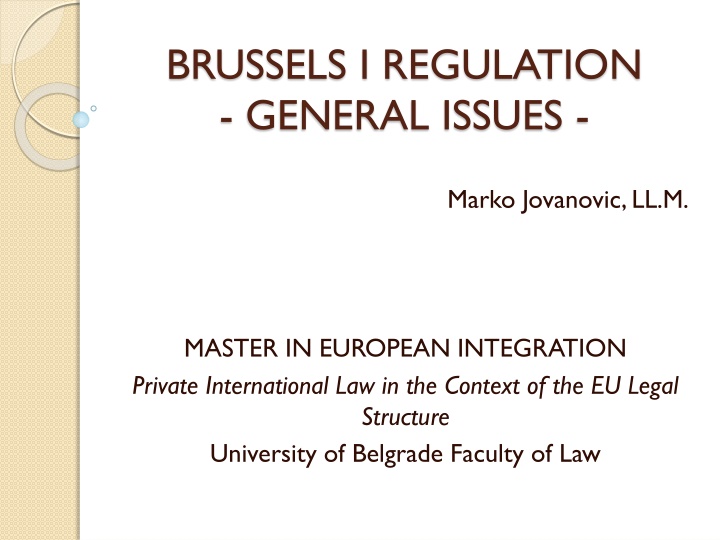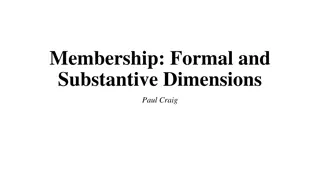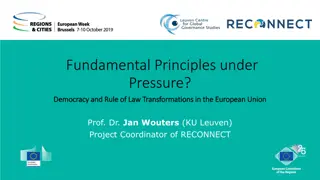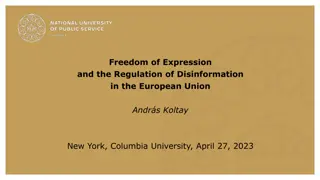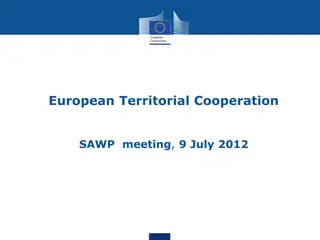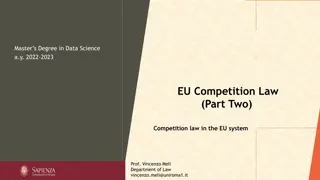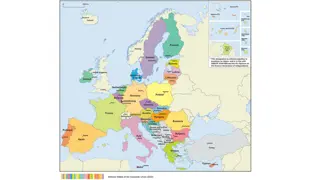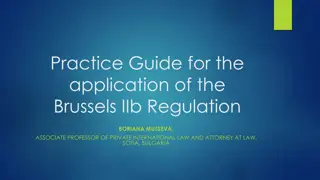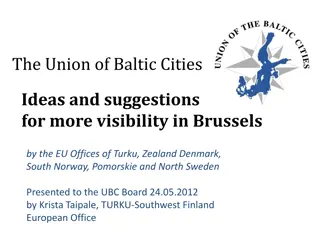Scope of Application of Brussels I Regulation in European Union
This content delves into the material scope of application of the Brussels Convention/Brussels I Regulation, focusing on civil and commercial matters while excluding administrative, criminal, and other specific areas. It explores the challenges in defining civil and commercial matters and provides insights into delimitation criteria for various legal domains within the EU context.
Download Presentation

Please find below an Image/Link to download the presentation.
The content on the website is provided AS IS for your information and personal use only. It may not be sold, licensed, or shared on other websites without obtaining consent from the author.If you encounter any issues during the download, it is possible that the publisher has removed the file from their server.
You are allowed to download the files provided on this website for personal or commercial use, subject to the condition that they are used lawfully. All files are the property of their respective owners.
The content on the website is provided AS IS for your information and personal use only. It may not be sold, licensed, or shared on other websites without obtaining consent from the author.
E N D
Presentation Transcript
BRUSSELS I REGULATION - GENERAL ISSUES - Marko Jovanovic, LL.M. MASTER IN EUROPEAN INTEGRATION Private International Law in the Context of the EU Legal Structure University of Belgrade Faculty of Law
Overview of procedural unification in European Union Diversity of jurisdictional regimes Brussels Convention (1968/1973) + Luxembourg Protocol (1971/1975) Regulation No. 44/2001 Brussels I (2000/2002)
Scope of application of the Brussels Convention/Brussels I Regulation 1. Material scope of application: civil and commercial matters, without extension to revenue, customs or administrative matters (Art.1) - definition: IN THE INTERPRETATION OF THE CONCEPT CIVIL AND COMMERCIAL MATTERS FOR THE PURPOSES OF THE APPLICATION OF THE CONVENTION OF 27 SEPTEMBER 1968, IN PARTICULAR TITLE III THEREOF , REFERENCE MUST BE MADE NOT TO THE LAW OF ONE OF THE STATES CONCERNED BUT, FIRST, TO THE OBJECTIVES AND SCHEME OF THE CONVENTION AND, SECONDLY, TO THE GENERAL PRINCIPLES WHICH STEM FROM THE CORPUS OF THE NATIONAL LEGAL SYSTEMS. (LTU Lufttransportunternehmen v. Eurocontrol, C-29/76, 14.10.1976)
Material scope of application - difficulties with respect to the definition of the term civil and commercial matters A. delimitation from administrative matters (not covered by Convention/Regulation) B. delimitation from criminal matters (not covered by Convention/Regulation)
Material scope of application A. Delimitation from administrative matters - two cumulative criteria 1. one of the parties has been conferred public authority; 2. the party has exercised that public authority in performing the activity which led to the dispute
Material scope of application B. Delimitation from criminal matters - difficulties with respect to delimitation in Common Law countries - criterion of protection of public interest
Material scope of application Excluded matters: 1. Status or legal capacity of natural persons, rights in property arising out of a matrimonial relationship, wills and successions; 2. Bankruptcy, proceedings relating to the winding-up of insolvent companies or other legal persons, judicial arrangements, compositions and analogous proceedings; 3. Social security; 4. Arbitration.
Scope of application II. Territorial scope of application - no precise indications in the Convention/Regulation/Treaties - special position of Denmark with respect to Brussels I until 1 July 2007 - position of overseas territories (2 groups) - special case of Danish territories (Greenland and Faroe Islands) - application on dependent territories (Gibraltar) - non-application to Andorra, Monaco, San Marino, Lichtenstein and the Vatican
Interpretation of the Convention / Regulation Two possible approaches to interpretation of international instruments 1. Autonomous interpretation 2. Interpretation in the light of the standards contained in domestic law Arguments in favor of autonomous interpretation Arguments in favor of interpretation in the light of domestic law standards
Interpretation of the Convention / Regulation Authority to interpret the Convention/Regulation Principle of interpretation: THE CONVENTION OF 27 SEPTEMBER 1968 MUST BE INTERPRETED HAVING REGARD BOTH TO ITS PRINCIPLES AND OBJECTIVES AND TO ITS RELATIONSHIP WITH THE TREATY. AS REGARDS THE QUESTION WHETHER THE WORDS AND CONCEPTS USED IN THE CONVENTION MUST BE REGARDED AS HAVING THEIR OWN INDEPENDENT MEANING AND AS BEING THUS COMMON TO ALL THE MEMBER STATES OR AS REFERRING TO SUBSTANTIVE RULES OF THE LAW APPLICABLE IN EACH CASE UNDER THE RULES OF CONFLICT OF LAWS OF THE COURT BEFORE WHICH THE MATTER IS FIRST BROUGHT, THE APPROPRIATE CHOICE CAN ONLY BE MADE IN RESPECT OF EACH OF THE PROVISIONS OF THE CONVENTION TO ENSURE THAT IT IS FULLY EFFECTIVE HAVING REGARD TO THE OBJECTIVES OF ARTICLE 220 OF THE TREATY. (Tessili v. Dunlop, C-12/76, 6.10.1976)
Interpretation of the Convention / Regulation Meaning of the principle: purposive interpretation (meaning of a rule must be found in the light of its underlying purpose) Application of the principle of interpretation: 1. Identification of the principles of Convention/Regulation 2. Interpretation of the applicable provision in the light of the meaning of the principles of Convention/Regulation
Interpretation of the Convention / Regulation The guiding principle of the Convention / Regulation: STRENGTHENINGTHE LEGAL PROTECTION OF PERSONS ESTABLISHED INTHE COMMUNITY/UNION General principles of the Convention / Regulation 1. Legal certainty 2. Protection of the right of defense 3. Free movement of judgments 4. Disputes should be decided by an appropriate court
Interpretation of the Convention / Regulation Problem of conflicting principles Guidelines for resolving the problem: 1. Consistency (cases that are alike from the standpoint of the legal principle are to be treated alike) 2. Optimization (the decision should be formulated in a way that maximizes the realization of the principle in question) 3. Prohibition of disproportion (a conflicting principle should not be sacrificed over a reasonable degree)
Relationship between BC/BR1 and conventions on specific matters General principle: the Regulation shall not affect any conventions to which the MS are parties and which, in relation to particular matters govern jurisdiction or the recognition or enforcement of judgments (Art. 71.1) Consequence of the principle: if both BR1 and a specific convention govern the same procedural issue, the specific convention prevails. If the specific convention is silent on an issue, BR1 applies
BR1 and the Lugano Convention Parallel convention to the Brussels Convention Concluded in 1988 between EFTA countries Semi-open convention (system of invitation) Fundamental principles identical to the ones of the BC/BR1 No power of interpretation for ECJ, however its decisions enjoy great authority de facto The Lugano Convention as a preparatory stage for candidate States before accession? (case of Poland) Revised Lugano Convention (2007)
